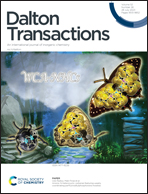Coumarin-modified ruthenium complexes by disrupting bacterial membrane to combat Gram-positive bacterial infection†
Abstract
Antibiotic abuse has caused the generation of drug-resistant bacteria and a series of infections induced by multidrug-resistant bacteria have become a threat to human health. Facing the failure of traditional antibiotics, antibacterial drugs with new molecular and action modes urgently need to be developed. In this study, ruthenium complexes containing coumarin were designed and synthesized. By altering the structure of the ancillary ligand, we explored the biological activities of four ruthenium complexes against Staphylococcus aureus. Among them, Ru(II)-1 with the best antibacterial activity (minimum inhibitory concentration: 1.56 μg mL−1) was used for further investigations. Surprisingly, Ru(II)-1 could significantly inhibit the formation of biofilm and hinder the development of drug-resistant bacteria. Besides, Ru(II)-1 also exhibited excellent biocompatibility. Antibacterial mechanism studies suggested that Ru(II)-1 could target the bacterial cell membrane and combine with the phospholipid component of the membrane (phosphatidylglycerol and phosphatidylethanolamine) and generate reactive oxygen species to induce an oxidative stress response, which resulted in the damage of membrane integrity, finally leading bacteria death. Moreover, antibacterial tests in G. mellonella larvae and mice in vivo model indicated that Ru(II)-1 had the potential to combat S. aureus infection. Therefore, all the above results showed that ruthenium complexes modified with coumarin could be a promising antibacterial agent to tackle bacterial infection problems.



 Please wait while we load your content...
Please wait while we load your content...